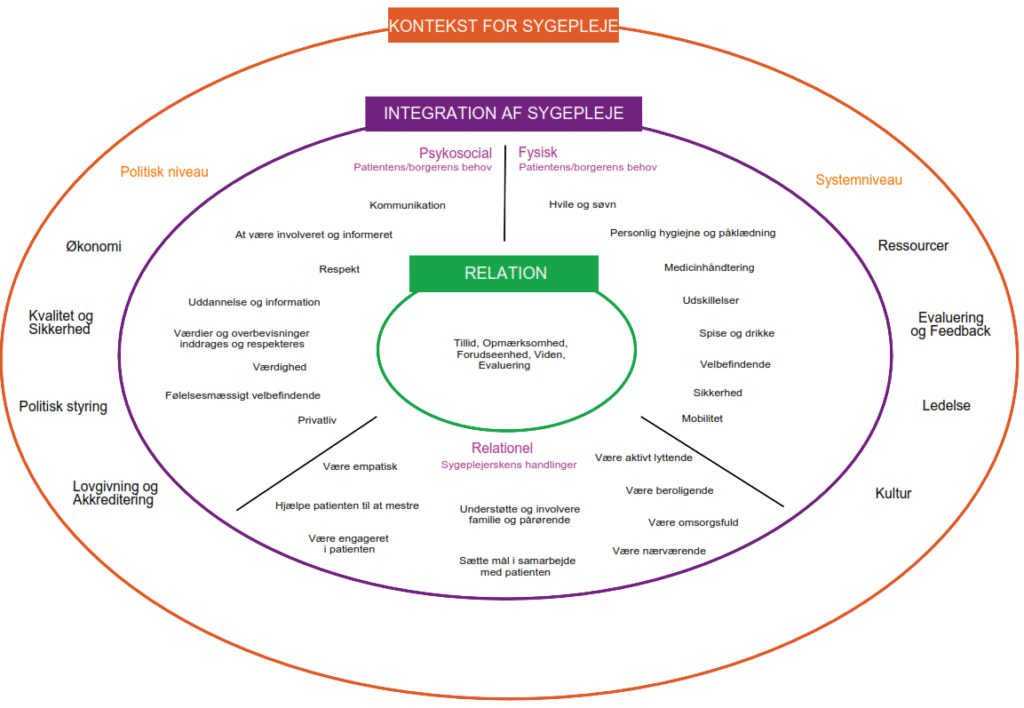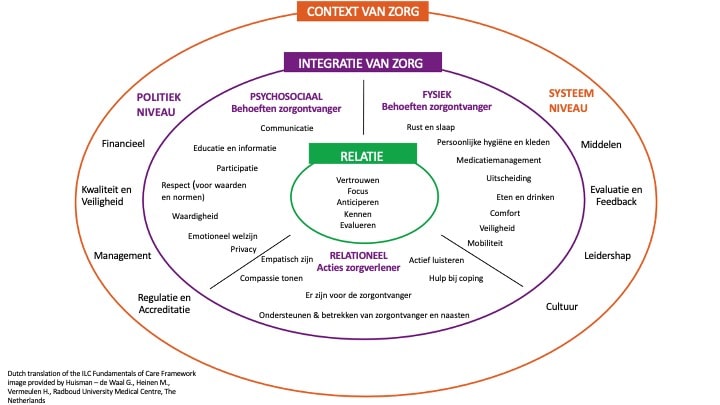The Fundamentals of Care Framework outlines what is involved in the delivery of safe, effective, high-quality fundamental care, and what this care should look like in any healthcare setting and for any care recipient.
The Framework emphasises the importance of nurses and other healthcare professionals developing trusting therapeutic relationships with care recipients and their families/carers. It also emphasises the need to integrate people’s different fundamental needs; namely their physical (e.g., nutrition, mobility) and psychosocial needs (e.g., communication, privacy, dignity), which are mediated through the nurses’ relational actions (e.g., active listening, being empathic). The Framework also outlines that the context in which care is taking place must support care providers to develop relationships and integrate the needs of those for whom they are providing care.
The Fundamentals of Care Framework was created from the expertise and experience of ILC members. The Framework has continued to stand as the ILC’s position paper and has been used in subsequent research and education activities by ILC members. The ILC continues to refine and improve the Framework to ensure it meets the needs of clinicians, consumers., educators, and researchers worldwide.
A copy of the Framework by authors Alison Kitson, Tiffany Conroy, Kerry Kuluski, Louise Locock and Renee Lyons, entitled Reclaiming and redefining the Fundamentals of Care: Nursing’s response to meeting patients’ basic human needs, published by The University of Adelaide, can be found here.

The Fundamentals of Care Framework outlines three core dimensions for the delivery of high-quality fundamental care:
- A trusting therapeutic relationship between care recipient and care provider
- Integrating and meeting a persons’ physical, psychosocial and relational needs
- A context of care that is supportive of relationship development and care integration
The ILC Fundamentals of Care Framework in English, French, Danish, Norwegian, Portuguese Dutch and Spanish
Using the Fundamentals of Care Framework image: The ILC provides permission for use of the Fundamentals of Care Framework image, as displayed on this web page, for publication in journal articles, reports, conference presentations and other materials. Use of the image must be cited/referenced in the following way:
- Image obtained from https://ilccare.org/the-fundamentals-of-care-framework/
- Content within image derived from Feo, R., Conroy, T., Jangland. E., Muntlin Athlin, Å., Brovall, M., Parr, J., Blomberg, K., & Kitson, A. (2017). Towards a standardised definition for fundamental care: A modified Delphi study. Journal of Clinical Nursing, 27, 2285-2299. doi: 10.1111/jocn.14247
When using the French translation of the ILC Fundamentals of Care Framework image please also include the following bullet point:
- French translation of the ILC Fundamentals of Care Framework image provided by Rey S., Savoie C., Quebec City (Quebec), Canada
When using the Danish translation of the ILC Fundamentals of Care Framework image please also include the following bullet point:
- Danish translation of the ILC Fundamentals of Care Framework image provided by Grønkjær, M, Aalborg University Hospital & Aalborg University, Denmark
When using the Norwegian translation of the ILC Fundamentals of Care Framework image please also include the following bullet point:
- Appreciation to PhD student Nordaunet, O.M., and the programmatic research platform “Continuity for Quality of Care and Health” at Lovisenberg Diaconal University College Norway 2023, for translation
When using the Portuguese translation of the ILC Fundamentals of Care Framework image please also include the following bullet point
- Portuguese translation of the ILC Fundamentals of Care Framework image provided by Henriques, A., & Costa, A., Nursing School of Lisbon, Lisbon, Portugal
When using the Spanish translation of the ILC Fundamentals of Care Framework image please also include the following bullet point
- Spanish translation of the ILC Fundamentals of Care Framework image provided by Desirée Mena Tudela; RN,MSc, PhD – Department of Nursing. Universitat Jaume I (Castellón, Spain)
When using the Dutchch translation of the ILC Fundamentals of Care Framework image please also include the following bullet point:
- Dutch translation of the ILC Fundamentals of Care Framework image provided by Huisman – de Waal G., Heinen M., Vermeulen H., Radboud University Medical Centre, The Netherlands
When using the Swedish translation of the ILC Fundamentals of Care Framework image please also include the following bullet point:
- Reference: Muntlin, Å & Jangland, E. (Red.) (2020). Fundamentals of Care. Klinisk tillämpning av ett teoretiskt ramverk för omvårdnad. Lund: Studentlitteratur. See also; Muntlin Å, Jangland E. Translation and cultural adaptation of the fundamentals of care framework: Are we there yet? J Adv Nurs. 2023 Mar;79(3):1107-1118. doi: 10.1111/jan.15383.
Altering the image in any way prior to its use and distribution must approved by the ILC by contacting ILC Support: [email protected]. Permission to alter the image will be granted on a case-by-case basis.
We welcome translations to be submitted for inclusion in the ILC FoC Framework images. Please contact the ILC team to submit your translation.
Dimension 1: The Relationship
- Developing and maintaining trust
- Focusing on the patient/person being cared for
- Anticipating the patient’s/person’s needs
- Getting to know the patient/person and how best to provide care for them
- Evaluating the quality, progress, and outcomes of the relationship


Dimension 2: Integration of Care
Physical fundamentals of care (care recipient’s needs and outcomes)
- Personal cleansing (including oral/mouth care) and dressing
- Toileting needs
- Eating and drinking
- Rest and sleep
- Mobility
- Comfort (e.g., pain management, breathing easily, temperature control)
- Safety (e.g., risk assessment & management, infection prevention, minimising complications)
- Medication management.
Psychosocial fundamentals of care (care recipient’s needs and outcomes)
- Communication (verbal and non-verbal)
- Being kept involved and informed
- Privacy
- Dignity
- Respect
- Education and information
- Emotional wellbeing
- Having values and beliefs considered and respected


Relational fundamentals of care (care provider’s actions)
- Active listening
- Being empathetic
- Engaging with patients
- Being compassionate
- Being present and with patients
- Supporting and involving families and carers
- Helping patients to cope
- Working with patients to set, achieve, and evaluate progression of goals
- Helping patients to stay calm
Dimension 3: The Context of Care
This includes policy and systems level factors that impact on the care provider’s ability to develop a relationship with the person being cared for and to attend, in an integrated manner, to their fundamental needs.
For more on the Fundamentals of Care Framework, watch the short animated video featured above, developed by Drs Mandy Archibald, Rebecca Feo, Tiffany Conroy and Professor Alison Kitson.










